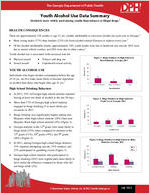The Georgia Department of Public Health
Youth Alcohol Use Data Summary
Alcohol is more widely used among youths than tobacco or illegal drugs.1
HEALTH CONSEQUENCES
There are approximately 158 youths (< age 21 yrs.) deaths attributable to excessive alcohol use each year in Georgia.2 More young males (77%) than females (23%) die from alcohol-related illnesses or injuries every year.2
Of the alcohol-attributable deaths, approximately 34% youth deaths were due to homicide and suicide, 46% were due to motor vehicle crashes, and 20% were due to other causes.2
Youth alcohol use is associated with increased risk for:
Physical assault Sexual assault
Tobacco and drug use Unprotected sexual activity
Figure 1: Binge Drinkers in High School by Race/Ethnicity, Georgia, 2011
100
Percent (%)
YOUTH ALCOHOL USE
Individuals who begin alcohol consumption before the age of 14 yrs. are five times more likely to become dependent on alcohol than those who begin after age 21 yrs.3
High School Drinking Behaviors
80
60
40 24
20
9
0
White, non-Hispanic Black, non-Hispanic
Race/Ethnicity
18
Other
In 2011, 35% of Georgia high school students reported having at least one drink of alcohol in the last 30 days.
More than 17% of Georgia high school students engaged in binge drinking (5 or more drinks per occasion) in 2011.
Binge drinking was significantly higher among nonHispanic white high school students (24%) than nonHispanic black high school students (9%) (Figure 1).
Georgia students in the 12th grade were more likely to binge drink (23%) when compared to students in the 11th grade (11%), 10th grade (19%), and 9th grade (20%) (Figure 2).
In 2011, among Georgia high school binge drinkers, 31% reported attempting suicide, 55% smoked, and 27% participated in gambling events (Figure 3).
Georgia high school students who participated in binge drinking (26%) were significantly more likely to drive under the influence compared to those who did not binge drink (2%).
Percent (%)
Percent (%)
Figure 2: Binge Drinkers in High School by Grade Level, Georgia, 2011
100
80
60
40
20
11
19
20
23
0 9th Grade 10th Grade 11th Grade 12th Grade
Grade Level
Figure 3: Binge Drinkers in High School by Risky Behavior, Georgia, 2011
100 Yes
80
No
60
55
40
31
20
16
0 Attempted Suicide
9
Smoking Risky Behavior
27 15
Gambling
2 Peachtree Street, Atlanta, Ga 30303 | health.state.ga.us
July 2012
Youth Alcohol Use Data Summary
Middle School Drinking Behaviors
In 2011, 34% of Georgia middle school students reported having at least one drink of alcohol in the last 30 days.
Middle school students aged 14 yrs. (44%) were more likely to drink alcohol when compared to those aged 12 yrs. (25%), and 13 yrs. (35%) (Figure 4). Drinking was more common among Georgia middle school students in the 8th grade (42%) than those in the 7th grade (36%) and 6th grade (23%) (Figure 5).
Percent (%) Percent (%)
Figure 4: Drinkers in Middle School by Age, Georgia, 2011
100
80
60
44
40
25
35
20
0 12
13
14
Age (yrs)
Figure 5: Drinkers in Middle School by Grade Level, Georgia, 2011
100
80
60
42
40
36
23
20
0 6th Grade
7th Grade
8th Grade
Grade Level
Data Sources:
2011 Georgia Youth Risk Behavioral Survey (YRBS): Conducted in collaboration between the Georgia Department of Public Health and the Georgia Department of Education and funded by the Centers for Disease Control and Prevention, Georgia Tobacco Youth Prevention Program, Maternal and Child Health Program, and the Georgia Department of Behavioral Health and Developmental Disabilities, the YRBS is conducted on a sample of 50 public high schools and 50 public middle schools every odd year in Georgia.
References: 1. The Surgeon General's Call to Action to Prevent and Reduce Underage Drinking. Rockville, MD: U.S. Department of Health and Human Services; 2007. 2. 2001-2005 Alcohol-Related Disease Impact (ARDI) Software, CDC (http://www.cdc.gov/Alcohol/ardi.htm) 3. Hingson RW, Heeren T, Winter MR. Age at drinking onset and alcohol dependence: age at onset, duration, and severity. Pediatrics 2006;160:739746
More data on alcohol use in Georgia can be found at http://www.health.state.ga.us/epi/cdiee/alcohol.asp
